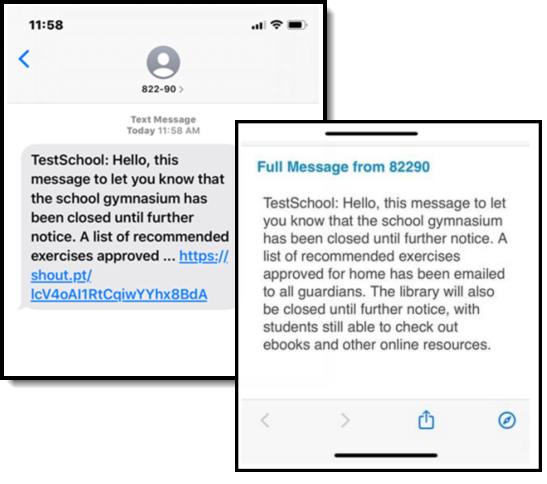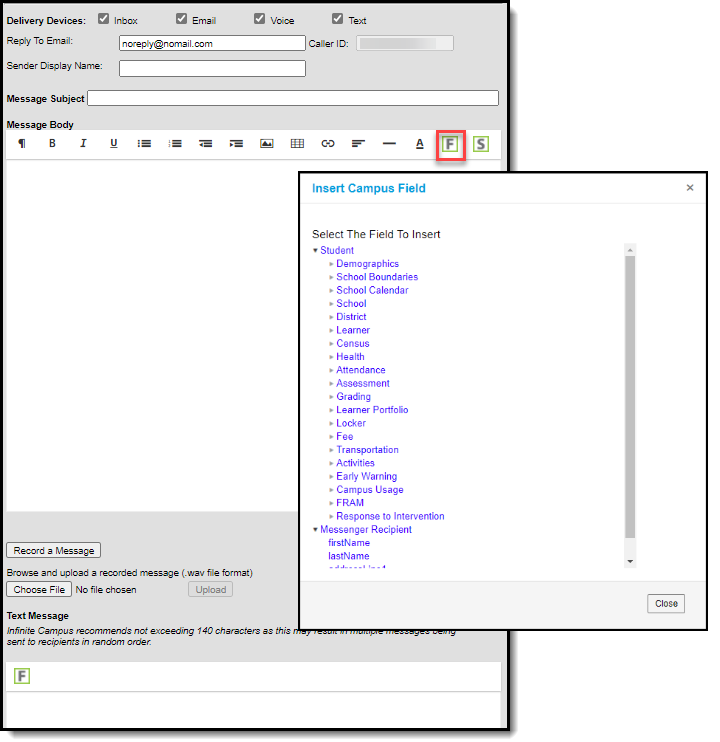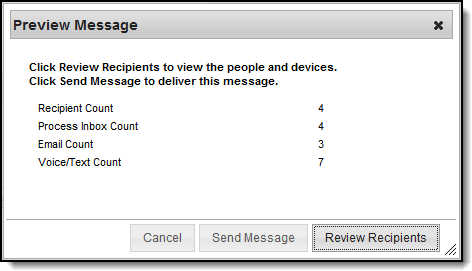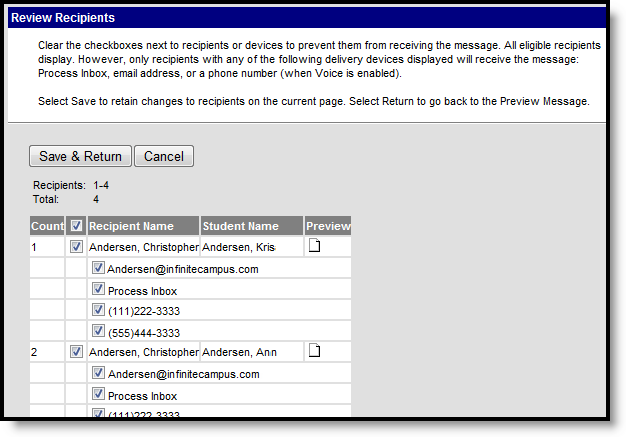The Message Builder tool allows a user to build and send messages to students and/or guardians. Depending on the messaging options used by the district/school, this tool may be used to create inbox, email, voice and/or text messages. The Message Builder tool uses saved ad hoc filters and messages templates as a basis for building messages.
If an enrolled student who is an emancipated minor has a non-Household Messenger relationship box selected for themselves on the Relationships tab, the Message Builder sends messages to the student when Student Messenger Contacts is selected in Message Builder and the student meets the other filter criteria selected for the message.

Field Descriptions
| Field | Description | ||||||
|---|---|---|---|---|---|---|---|
| User/Group | This dropdown list allows you to save message templates to your user account or a user group to which you belong. You must have Read Tool Rights to User Group Formats under this tool in order to share templates among the groups to which you belong. | ||||||
| Template | This dropdown list displays a list of available templates. To create a new template, select <new> from this list. Templates save to either the User (default), or User Group where they are accessible to other members in the group. Minimize future message setup time by creating and saving templates. Templates save:
| ||||||
| Filter Criteria | |||||||
| Message Type | This field determines the type of message that is sent. The following options are available:
| ||||||
| Deliver To: |
See the topic About Call Chaining in the Messenger with Voice - Setup and Details article for more information about how Voice Messenger and Shoutpoint distribute voice messages. | ||||||
| Enrollment Filter: Message Only Active Students | When this checkbox is marked, Messenger sends the message to students who meet the following criteria:
If this checkbox IS NOT marked, the message will deliver to all individuals who pull based on the Saved Filter, regardless of enrollment. | ||||||
| Limit delivery to contacts that speak: | This field allows messages to be filtered to any household language based on the value selected in the Preferred Language field in Census > People > Demographics > Personal Contact Information (section). The default selection for this field is 'No Language Preference'. This option allows messages to be sent out to all recipients regardless of their Preferred Language type. If a language is selected, only recipients whose Preferred Language in Demographics matches the language selection here will receive the message. | ||||||
| Saved Filters | This is a list of saved student type Ad hoc filters. | ||||||
| Set Filter Operation | This field determines what the tool should do with the filters. The default value Union is used most often. Union indicates that all members of all selected filters are included. Intersection indicates that only the members who exist within each of the selected filters are included. | ||||||
| Delivery Devices | |||||||
| Inbox | The Inbox option is automatically selected. This option places a note in the parent's inbox that a new message is available. Infinite Campus strongly recommends leaving this option marked to ensure delivery to a Portal Account when no other delivery devices are marked for messages. | ||||||
| The Email option sends an email to the guardian's email address on record (entered in Census > People > Demographics). | |||||||
| Voice | The Voice option calls the guardian's phone number on record (entered in Census > People > Demographics). Sub-reports cannot be added to Voice messages. | ||||||
| Text | The Text option sends a text message to the guardian's mobile device. Recipients who have indicated a desire to receive text messages must have the Text (SMS) checkbox marked in the Personal Contact Information editor of the Demographics tab to receive text messages. Sub-reports cannot be added to Text messages. | ||||||
| Message Details | |||||||
| Reply To Email | This field displays the email address that is automatically included in the message body for message recipients to reference.
This field can be changed if the Allow Custom Sender's Email Address checkbox is marked on the Email Settings tab. Existing templates may display a different address if the the Allow Custom Sender's Email Address checkbox is marked and a user modified the Sender’s Email field. | ||||||
| Caller ID | This field displays the phone number that is automatically included in the message body for message recipients to reference.
This field can only be changed if the Allow Custom Caller ID checkbox is marked on the Voice Settings tab. Existing templates may display a different Caller ID if the Allow Custom Caller ID checkbox is marked and a user modified the Caller ID field. | ||||||
| Sender Display Name | Entries to this field will display in the recipient's email inbox for easier sender identification. This field is only available if the Allow Custom Sender Display Name checkbox is marked on the Email Settings tab AND Email is selected from the Delivery Devices options in the message template. | ||||||
| Message Subject | This field determines the text that displays in the Subject field of the email message. | ||||||
| Message Body | This field contains the text contained in the message. See the Campus Insert Fields for Message Builder section for important information about inserting Campus fields in the Message Body and the Text Message body. The Message Body uses a WYSIWYG editor. Do NOT copy attribute fields from another Messenger tool in Campus. The attribute fields are not the same. For more information about using the options available with the editor, see the WYSIWYG Editors article. Message Body supports the use of Chinese characters for email messages only. | ||||||
This option allows you to send a voice message. See the article Messenger with Voice - Setup and Details for more information about this feature. You must click the Upload button after browsing for the attachment. When an attachment is properly uploaded, the Attach File message displays on the screen. | |||||||
| Browse and upload an email attachment | This option allows you to add an attachment to the email. See the article File Types (Digital Repository) for information about supported file types. You must click the Upload button after browsing for the attachment. When an attachment is properly uploaded, the Attach File message displays on the screen. If you need to send multiple files, attach a zip file. This option is controlled by an email preference set by the District Administrator and may not display in all districts. File attachments are not sent to Messenger Inbox or Portal Inbox. File attachments are only received in email. | ||||||
| Text Message | The text message to be sent to the guardian's mobile device and are limited to 400 characters. The maximum length of a text message is set to 400 characters. A warning message displays when a message has reached the character limit and will prevent the message from being saved if the limit is exceeded. Campus recommends districts stay within a 140 single text character limit. Messages that exceed 140 characters, but remain within the 400 character maximum, should note the following:
Existing text message templates still display in their entirety, but need to be modified to be within this limit before sending. If users wish to stop receiving text messages, they can text STOP to the short code. This results in the user receiving no further text messages from Campus, even if the user has the Text option marked on their Contact Preferences. Users need to go through the opt in process again to start receiving texts at a later date. | ||||||
| Delivery Date: | The day on which the message should be sent. | ||||||
| Send Inbox/Emails at: | The time inbox and/or email messages begin delivery. The time saves with the templates. If messages should always go out immediately after Send is selected, this field should be left blank. | ||||||
| Dial Window | These fields create a dialing window during which a general voice message may be sent. The default values for these fields are set up on the Voice Settings tab (System Administration > Messenger > Messenger Preferences > Voice Settings). Dial Window times must be entered and saved with templates. If the start time entered on the message is earlier than the start time on the template (and the start time on the template is after the start time entered on the Voice Settings tab), Messenger uses the start time on the template and does not send the message until that time is reached. If the end time on the Dial Window is earlier than the end time entered on the Voice Settings tab, calls do not stop. Instead, they continue until the end time on the Voice Settings tab is reached. In addition, if a voice message is still delivering when the District end time is reached, message delivery stops and is not completed. | ||||||
Campus Fields and Sub-Reports for Message Builder
Campus Fields and Sub-Reports includes specific Message Builder fields for use in the Message Body WYSIWYG. Once a message is sent with a specific event (for behavior or attendance), the message is only sent once. If a student receives a message about an event that occurred on Monday, the message about that event is not be sent again.
Any ad hoc fields that have been deactivated display in red. Use the Element Replacement tool to locate deactivated elements and replace them with the new field.
Messages containing a sub-report, where a large recipient count exists, may take longer to send. Users should not navigate away from the page while the system is attempting to send the message.
Information in the letter sub-reports uses data stored in the AttendanceDayAggregation table. This means that attendance data for the current date is accurate as of the previous night's attendance calculation, or the last time the Attendance Aggregation Refresh was run. If needed, the Attendance Aggregation Refresh tool can be run to force an attendance recalculation to pull in the current day's data.
Sub-Report Options
The following table lists the sub-report options for each area.
| Area | Sub-Reports |
|---|---|
| Learner | Student Schedule Active and Dropped Student Schedule |
| Learner Planning | Course Requests Course Plan |
| Attendance | Period Mark Summary Course Mark Summary Whole/Half Day Summary Exact Day Summary Single Day Count Summary |
| Grading | Grade Detail Term GPA Summary |
| Behavior | Discipline Summary Behavior Summary |
| Student Portfolio | Cumulative GPA and Class Rank |
| Health | Immunization Health Screening Concussion Health Screening Dental Health Screening Hearing Health Screening Scoliosis Health Screening Vision |
| Point of Sale | POS Account Balance |
When using sub-reports in letters, please note the following:
- All behavior data is included when adding either of the sub-reports.
- A field only displays if there is data for that field. If a field is chosen from the sub-report but there is no saved data for that student, information for that field does not display.
- A sub-report option only displays if the district/school records that data.
Create a New Template
Templates allow you to create reusable messages that save time and standardize content.
- Select the <New> option from the Template dropdown list.
- Select User (default) or a User Group that the template should be saved to from the User/User Group dropdown field. Templates saved under a User Group are available to other members in the group.
- Use the Field Descriptions to complete the Message Builder editor.
The Message Body uses a WYSIWYG editor.
Do NOT copy attribute fields from another Messenger tool in Campus. The attribute fields are not the same.
For more information about using the options available with the editor, see the WYSIWYG Editors article.
- Click the Save button at the top message editor.
- Enter a name for the template in the pop-up box. The template appears in the Template dropdown list.
Delete a Template
- Select the template you want to delete from the Template dropdown list.
- Click the Delete button. A confirmation message displays.
- Click the OK button. Campus removes the template and it does not display in the Template dropdown list.
Create Messages
- Select an existing Template from the Template dropdown list.
- Use the Field Descriptions to complete Message Builder editor.
The Message Body uses a WYSIWYG editor. For more information about using the options available with the editor, see the WYSIWYG Editors article.
Browse and upload an email attachment. (optional)
You must click the Upload button after browsing for the attachment. When an email attachment is properly uploaded, the Attach File message displays on the screen.
Click the Test button.
Infinite Campus strongly recommends testing messages before delivering them. A message is sent in the exact manner it is delivered to recipients. The Test Message screen prompts you for a destination phone and/or email address then confirm that the test message was sent.
- Click the Preview/Send Message button. The Preview Message screen displays.
- Click the Review Recipients button. The Review Recipients screen displays.
Complete the following tasks on the Review Recipients screen. (Optional)
Task Description To exclude recipients/phone numbers Clear the checkbox next to a name or phone number. Preview the message Click the page icon in the Preview column. To exit and return to the Message Preview screen Click the Save & Return button if changes have been made to the recipient list. Otherwise, if no changes have been made, click the Cancel button. - Click the Send Message button on the Preview Message screen. The Preview Message screen displays. This screen confirms that the message tasks has been completely set up for delivery at the times entered in the Send Emails At and/or Dial Window fields of the main Message Builder screen. This screen does not indicate that the message is currently being sent.
- Click OK.







